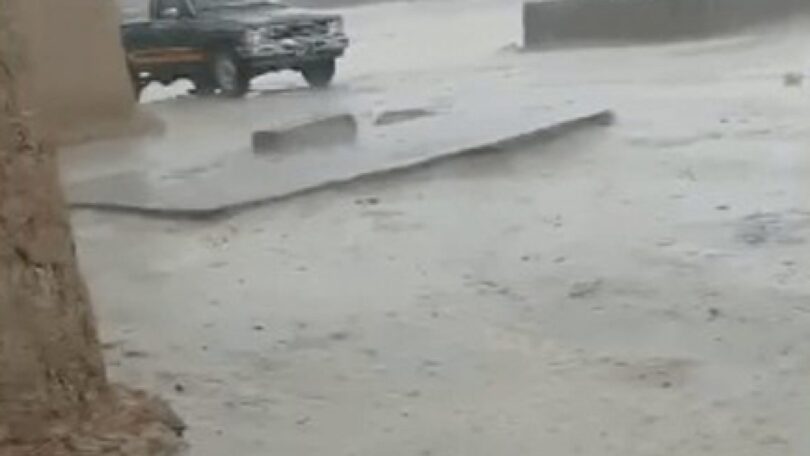The heavy showers left main roads and streets flooded with knee-high water and submerged low-lying areas in Gwadar, Kech, Kharan, Turbat, Pasni, Jiwani, and adjoining districts of Balochistan. Heavy rains suspended traffic and blocked connecting roads causing an urban flood-like situation in most cities in the province. Meanwhile, the Metrology Department has warned of flash flooding in the local nullahs of Gwadar, Kech, Turbat, and Panjgur, adding that snowfall may disrupt traffic in northern Balochistan. The Met department further informed the citizens that several other regions including Chagai, Noshki, Washuk, Mastung, Sibbi, Nasirabad, Zhob, Sherani, Barkhan, Musakhel, Kohlu, Jhal Magsi, Loralai, Ziarat, Quetta, Chaman, Pishin, Qila Abdullah and Qila Saifullah are likely to witness similar weather spill, with snowfall on hills, till March 13.
Pakistan’s Southern region including some parts of Sindh and Balochistan bracing for serious repercussions of heavy rains with urban flooding in Gwadar, Ormara, Sibbi Nasirabad, Zhob, and Qila Saifullah. The heavy rains inundated vast swathes of the province blocking road connectivity with the rest of the country as well as causing serious disruption in rescue and relief operations by the authorities. The provincial government and the NDMA have already launched relief activities in affected parts of the province. Prime Minister Shehbaz Sharif has recently paid an emergency visit to a rain-hit region, offered condolences over losses, and announced significant aid and compensation for flood victims in Balochistan. The NDMA in collaboration with King Salman Humanitarian Aid and Relief Centre (KS Relief) Pakistan, has mobilized an emergency relief program to support the flood victims of Gwadar, while Pakistan military and several NGOs also kicked start rescue and relief operations in rain-hit areas in Balochistan.
Pakistan is highly vulnerable to global warming and natural disasters because of its geographical location, topography, acute weather conditions, irregular growth, and untidy governance. Climate change has had significant impacts on Pakistan, particularly in the form of extreme weather events, water scarcity, glacial melt, and periodic heat waves in the country. Historically, our nation has been facing climate-induced weather events regularly that caused significant damage to the country’s infrastructure, economy, and population. The International Monetary Fund (IMF) has revealed in its report that Pakistan is among the most vulnerable countries to climate change which has been causing a $ 2 billion loss annually to the South Asian nation since 2000. As said, climate change affects four million people every year, while superfloods in 2022 impacted 30 million people and perished 1,700 lives causing the bulk of economic losses, and displacement. The report highlighted that Pakistan’s economy may be affected by natural disasters by up to 9% by the year 2050.
The climate-induced droughts, recurrent floods, glacier melt, and other natural disasters become customary in today’s Pakistan, but our leaders and governments were not well prepared to tackle those challenges effectively. In fact, half of the problem is the self-creation of the public and its leaders. No proper sanitation and drainage systems coupled with heavy encroachment in the cities, alongside waterways, and sewerage nullahs, and illegal construction in the rivers’ bed or on the bank of ravines, not only regularly obstruct waterways but cause floods in urban and hilly areas, resulting in significant human and economic losses on an annual basis. Each year, provincial governments allocate bulk funds for flood prevention that only quench the thrust of corrupt bureaucracy, Tahsildars, and patwaris in all four provinces. Presently, global warming has caused serious survival risks for the country, as monsoon floods have become a recurrent phenomenon on an annual basis. The reconstruction and rehabilitation work of the past superfloods has not yet been completed since a new wave of torrential rains exposed the government’s mismanagement and poor deliverance to the public. The government must reprioritize its PSDP, with a particular focus on infrastructure development, and flood prevention measures including removal of encroachment, broadening and clearance of sewerage passages, drainage lines, etc along with the construction of water reservoirs to stall flood risk and avoid huge economic losses to the country. The recent torrential rains in Sindh and Balochistan remind us of the devastation of monsoon flooding, leaving ample time on disposal to prepare for that challenge. It is a shared task and collective responsibility of the leaders as well as the public which must be taken as the priority, otherwise, ad-hoc measures, and post-flood scream are worthless and futile.







